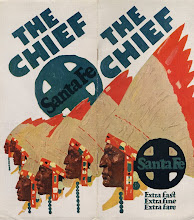ONE MORE CHANCE TO GET ANOTHER DOSE OF FDR'S "ALPHABET SOUP" CURE FOR THE GREAT DEPRESSION
The student-curated exhibition on display on the second floor of the Green Library on the Modesto Maidique campus of Florida International University was originally slated to come down on January 5th, but has been extended to the 12th of this month. The display features rare books and ephemera from the New Deal era selected, described, and interpreted by Mariana Clavijo, Jessica Tejeiro, Michelle Zavala, Christie Vina, Kevin Pineiro, Maria Aliano, and Miriam Kashem. These undergraduate students taking a course on the Great Depression and New Deal period in film and history this last fall opted to do an exhibition project using primary source materials garnered from the Wolfsonian-FIU library. This display examines several of the Roosevelt administration’s programs, including: the NRA (National Recovery Administration), the AAA (Agricultural Adjustment Administration), the FAP (Federal Arts Project), the FWP (Federal Writers’ Project), the FTP (Federal Theatre Project), the FMP (Federal Music Project), the NYA (National Youth Administration), the CCC (Civilian Conservation Corps), and the WPA (Works Progress Administration).
There is also a large flat screen virtual display of the exhibits created by six students taking the same course in the fall of 2008. Mario Montoya selected original programs and exhibition catalogs promoting the arts in various federal art galleries and government supported community art centers. Al Pena and Nicole Saltzmann, on the other hand, exhibited the politically-charged artwork of Socialist and Communist artists Lynd Ward, Giacomo Patri, and Hugo Gellert, whose artwork was critical of Roosevelt’s reforms as being insufficiently radical and transformative. Michelle Narganes and Brian Villar focused on the worst ecological catastrophe of the twentieth century–the dust storms that rolled across the Great Plains during the so-called dirty thirties. Finally, Robert Gueits used museum artifacts to bring to light the treatment and experiences of those African Americans enrolled in the Civilian Conservation Corps—the program which set three million young men to work planting trees and otherwise laboring to address the ecological crisis.





No comments:
Post a Comment